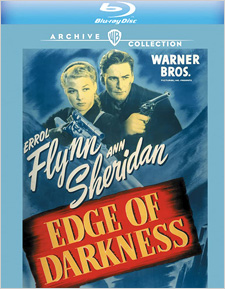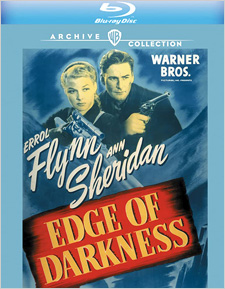Edge of Darkness (1943) (Blu-ray Review)

Director
Lewis MilestoneRelease Date(s)
1943 (January 18, 2022)Studio(s)
Warner Bros. Pictures (Warner Archive Collection)- Film/Program Grade: A
- Video Grade: A
- Audio Grade: B-
- Extras Grade: D+
Review
Edge of Darkness is one of many films made during World War II that championed the Allied cause against Nazis determined to put down any resistance with an iron hand. Ironically, the film was directed by Lewis Milestone, who had brought to the screen All Quiet on the Western Front, a powerful anti-war picture. Edge of Darkness, in contrast, is a propaganda film that espouses and even glorifies armed combat.
In the opening scene, a Nazi patrol plane passes over a Norwegian village that’s flying the Norwegian flag in defiance of the German occupiers. German troops are dispatched there and discover the village is strewn with Nazi and Norwegian dead and the troops’ commander, Capt. Koenig (Helmut Dantine), is in his office with a bullet hole in his head. In an extended flashback, we see the bitter conflict between the villagers and the Nazi invaders, particularly reactions to the stranglehold of the oppressors.
Among the villagers is a fisherman, Gunnar Brogge (Errol Flynn), who’s also a leader of the Norwegian resistance; his sweetheart, Karen Stensgard (Ann Sheridan); her doctor father (Walter Huston), who’s reluctant to join the cause; her clueless mother (Ruth Gordon); elderly school teacher Sixtus Andersen (Morris Carnovsky); Kaspar Torgersen (Charles Dingle), the town’s fish cannery owner and a Nazi sympathizer; war widow Gerd Bjarnesen (Judith Anderson); and Johann Stensgard (John Beal), Karen’s brother, who has already betrayed his countrymen once and can’t be trusted. The Norwegians secretly plot under the noses of the Nazis. Even as they endure oppression, they summon the discipline to wait for the right moment to strike.
This is not your typical Errol Flynn swashbuckler. Robert Rossen’s screenplay showcases each of the main characters, making the film an ensemble rather than a star-driven picture. Flynn’s trademark derring-do is virtually absent from the early part of the film, though he has some heroic moments in the film’s third act. The film is paced slowly in the first 45 minutes, with dialogue and exposition dominating. Numerous subplots support the main narrative. Director Milestone saves most of the action for the last 20 minutes, pulling out all the stops with excitingly staged set pieces.
Though many of the characters are fairly stereotypical, Carnovsky’s school teacher and Huston’s Dr. Stensgard stand out. Carnovsky has an excellent scene in which he confronts Capt. Koenig with a philosophical approach—his way of resisting. The teacher’s refusal to let the Germans use his home for a barracks infuriates the captain, who decides to make an example of him. Dr. Stensgard is conflicted about the morality of the resistance, though he continues to have the respect of his fellow villagers. He never appears weak for his lack of commitment, but genuinely concerned for the consequences that may be loosed on the villagers.
Edge of Darkness was one of several films released around the same time that dealt specifically with the Norwegian resistance to German occupation during World War II. Others include They Raid By Night, Commandos Strike at Dawn, and First Comes Courage.
Edge of Darkness was shot by director of photography Sid Hickox with spherical lenses on black-and-white 35 mm film, finished photochemically, and presented in the aspect ratio of 1.37:1. Warner Archive brings the film to Blu-ray with excellent clarity and contrast for a film that’s nearly 80 years old. The picture has a nice silvery tone with deep, rich blacks. Much of the story takes place indoors with typical room lighting, but action is opened up to show the town square and village houses (all on the Warner back lot) as well as some scenes in a forest. Extras were well chosen to pass as Norwegian villagers. The cinematography is fairly standard, with few examples of cinematic pizzazz. Miniatures of German ships approaching the village stand in for the real thing and rear projection is used in some scenes, with projected images backing the actors.
The English 2.0 mono DTS-HD Master Audio soundtrack is a bit problematic. Dialogue is not as sharp as other Warner Archive releases. It has a somewhat muddy quality. None of the actors speak with a Norwegian accent. In one scene, however, actors sing a hymn in Norwegian. Sound effects include machine gun fire, explosions, rifle fire, battle chaos, and an airplane engine. English SDH subtitles are an available option.
Bonus materials include the following:
- Gun to Gun (17:37)
- To Duck... or Not to Duck (6:40)
- Theatrical Trailer (2:17)
In the short subject Gun to Gun from 1944, a cowboy (Robert Shayne, Inspector Henderson on the TV series The Adventures of Superman) foils a plot to steal Spanish land-grant deeds. Lupita Tovar (the Spanish Dracula) co-stars. In the Looney Tunes cartoon To Duck… or Not to Duck from 1943, Daffy Duck challenges Elmer Fudd to a boxing match, rigged in his favor with the collusion of the duck referee.
Made during the grim days of the German blitzkrieg, Edge of Darkness pays tribute to the heroic spirit of common people taking up arms against the Nazi invaders. With Errol Flynn tamping down his swashbuckler image to provide an understated performance, and a first-class supporting cast, the film is not a typical war picture. It takes its time documenting the indignities to which the villagers are subjected before it lets loose with a solid action denouement.
- Dennis Seuling

